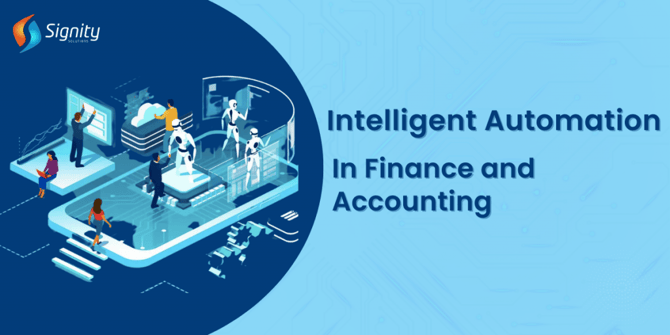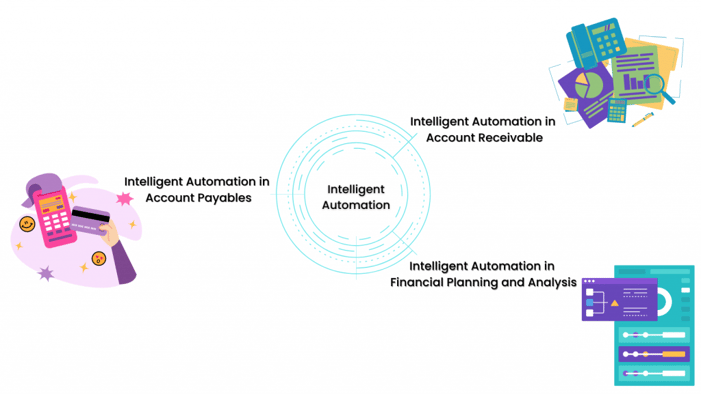Intelligent Automation - A Winning Variable in Ever-Evolving F&A World

“Change is the only constant” - A Greek Philosopher Heraclitus quotes these wise words, but little did he know how true they will be today. In fact, “Change” is the only thing to count on in these uncertain times. Though, it doesn’t mean it’s predictable.
In the fast-paced world of finance and accounting (F&A), AI can also help CFOs and their finance teams steer their organizations with improved agility, sharper insights, better-informed, data-backed decisions, and reduced risk and costs.
So, whether it’s ever-evolving finance and accounting (F&A), Covid-19 variants, or low employee retention, organizations have no idea what’s coming next. Still, some companies have thrived among the never-ending uncertainty.
How?
What’s the variable in the change equation that distinguishes the leaders from the laggards?
“Intelligent Automation”
But, how to navigate this ever-evolving intelligent automation journey? Where to start? What actually is termed intelligent automation?
Let's start with the first and foremost.
What is Intelligent Automation in Finance?
The amalgamation of Robotic Process Automation (RPA), with Artificial Intelligence, and other emerging technologies like Analytics, Optical Character Recognition (OCR), Intelligent Character Recognition (ICR), and Process Mining to build end-to-end business processes that can think, learn and adapt on their own.
In layman’s terms,
Intelligent Automation = True Value of Human + Machine Collaboration
Intelligent automation in finance and accounting makes processes and operations more agile and resilient, making it easier for businesses to react, adapt, and embrace change.

In addition, the C-suite believes in the benefits that intelligent automation offers. According to the Kofax 2022 Intelligent Automation Benchmark Study, a great majority of (90%) of global executives consider automating workflows post-COVID-19 will ensure business continuity.
In addition, approximately 89% thought digitally transformed companies had a competitive advantage.
If you are of the mind to achieve true digital workflow transformation, there’s no denying intelligent automation to the areas of business that are just undeniable to success. When done correctly, businesses develop the agility and resilience needed to balance the equation of change.
Rethinking Finance and Accounting With Intelligent Automation
Without any ado, let’s understand intelligent automation use cases in detail; how it is integrated into the back-office processes of Finance, like Account Receivable (AR), Account Payable (AP), and Financial Planning and Analysis (FP&A) that are unskippable elements in the functioning of any organization.
|
In simple words, automating the finance and accounting industry needs unflagging precision, and here Intelligent Automation comes in the big picture.
Challenge 1: Account Receivable
Account Receivable (AR), as defined, is the balance or payment by an organization for the use or purchase of its products, services, or goods.
Though there are companies still using humans for their account receivables process, and often encounter challenges of errors in invoicing, leading to delayed payments, credited invoices, and other disruptive and daunting issues.
Therefore to overcome the challenges of accounts receivable, automation is crucial.
Solution:
Intelligent Automation optimizes the account receivable process and helps distribute customer invoices electronically despite your customer’s digital capabilities. Besides, rules can be altered based on each customer’s needs and requirements, generating a complete digital workflow.
Also, it brings in minimized distribution costs, quicker payments and invoice handling, improved cash flow, maximized accuracy and security, and, most importantly, customer relations.
Challenge 2: Account Payables
As termed, Account Payables is a liability and a short-term debt on a balance sheet where a business has to pay an amount to its vendors/merchants/providers that have furnished the business with services or goods on credit.
Although, the most high-risk job in the financial service industry is managing payments. Account payables serve the ideal automation conditions and assure a more prominent Return On Investment (ROI). So, to streamline the account payables process, Account Payables Automation is a must.
Solution:
It may sound daunting initially, but the timeline for sending and receiving payables can be automated.
Robotic Process Automation (RPA) bots can create approval workflows and process payments and receipts. Also, it ensures that all the transactions take place on time and that all financial audit policies and regulations are adhered to.
Challenge 3: Financial Planning and Analysis
Financial Planning and Analysis (FP&A) involves activities that brace an organization’s financial health. These activities are:
- Planning and budgeting
- Predicting and modeling
- Integrated financial planning
- Management and performance reporting
So, when these are not automated and managed through emails, spreadsheets, and attachments, it leads to inefficiency. There is a high probability of delays, lack of visibility, and improper approvals.
So, organizations running F&A manually would fall deficit of resources to make forecasts at a faster cycle time as they need regular updates on the latest financial statements, capital expenditures, and investments making for weak financial planning.
Solution:
Performing analysis on the latest financial trends is instrumental for more online visibility over the workforce. In addition, process automation helps reduce process inefficiencies, increase process visibility leading to better decision-making, and maintain a stronger, more transparent relationship with business units and departments.
Some Other Added Benefits are:
- Reduced operational costs
- Improved accuracy by approximately ~ 99.9% along with compliance because of reduced human errors.
- Improved decision-making capabilities
- Faster processing time, increased productivity, and reduced average managing time by 35-50%.
- 24*7*365 availability: BOT executes tasks even during odd working hours.
F&A Processes Where Intelligent Automation Can be Implemented
| Account Receivable | Account Payable | Financial Planning & Analysis | |
| Sub-Processes |
|
|
|
| Robotization % | 100% | ~70-80% | ~80-85% |
| Advantages |
|
|
|
Finally…
Intelligent Automation's iterative and granular nature portrays a modest upfront investment that can bring phenomenal returns, which can fund further transformation.
Besides, the transformative benefits of Intelligent Automation in finance can ultimately be leveraged when technology and tools match by deep understanding and experience for their implementation and the processes they apply. And when this happens, the finance function will be considered the nerve centre of the enterprise, allowing businesses and organizations to rethink their future.


%201-1.webp)


.png?width=344&height=101&name=Mask%20group%20(5).png)

















